Task 2: Analysis of Pathophysiology in Disease Case Studies
VerifiedAdded on 2022/09/15
|7
|1882
|18
Case Study
AI Summary
This document presents a case study analysis focusing on the pathophysiology of various diseases. The content includes detailed scenarios of diseases such as gout, Lyme disease, osteoporosis, rheumatoid arthritis, ankylosing spondylitis, lateral epicondylitis, status epilepticus, multiple sclerosis, myasthenia gravis, Alzheimer's disease, spinal cord injury, traumatic brain injuries, cerebral artery vascular accident, osteoarthritis, and fibromyalgia. Each scenario provides a concise overview of the disease, its causes, and relevant pathophysiological mechanisms. The document also includes citations to support the information presented. The case study format allows for an in-depth exploration of the diseases, aiding in the understanding of their clinical presentations and underlying biological processes. The analysis covers a range of conditions, providing a comprehensive view of different disease states and their impact on the human body. References from various sources are provided for further exploration.
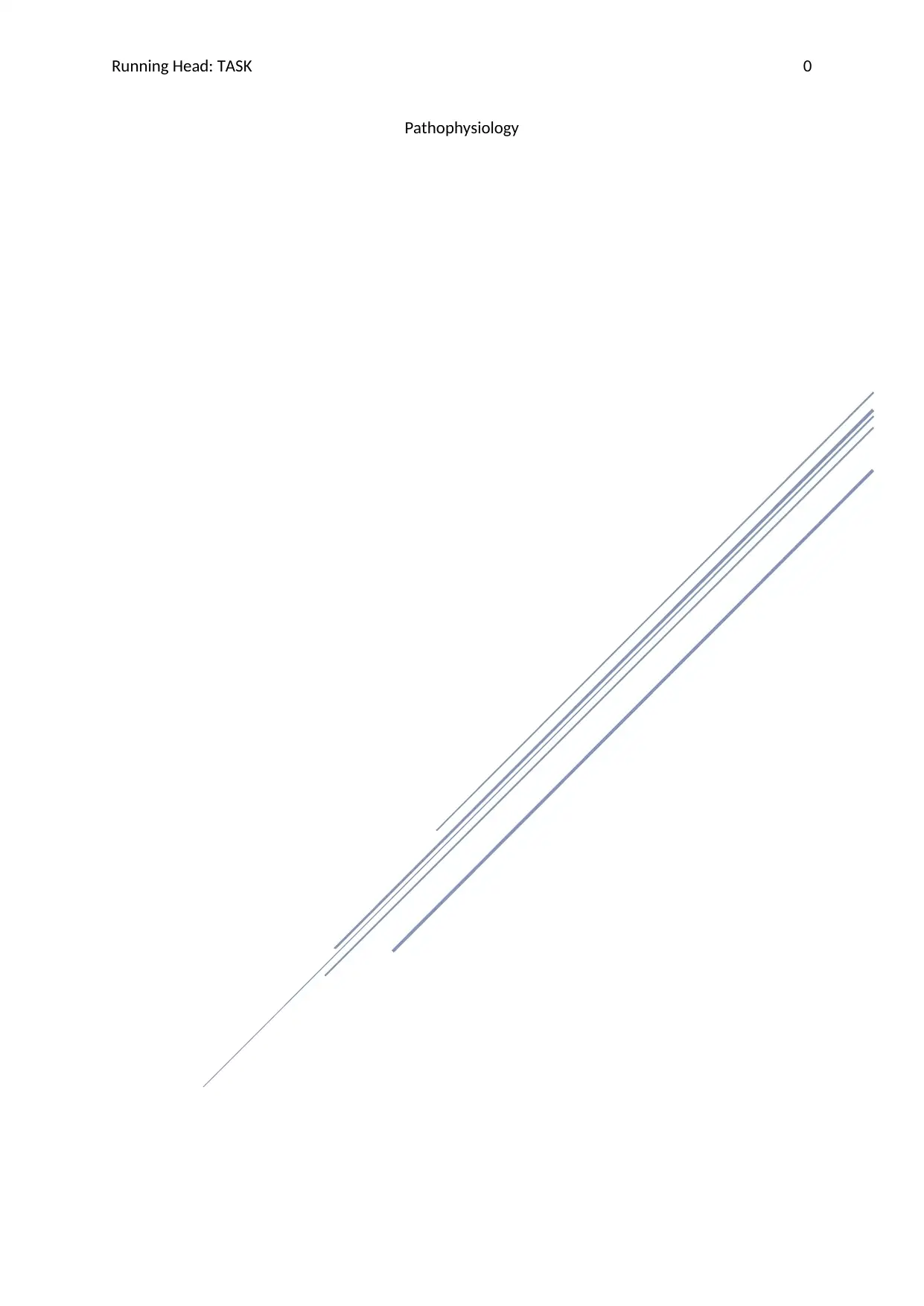
Running Head: TASK 0
Pathophysiology
Pathophysiology
Paraphrase This Document
Need a fresh take? Get an instant paraphrase of this document with our AI Paraphraser
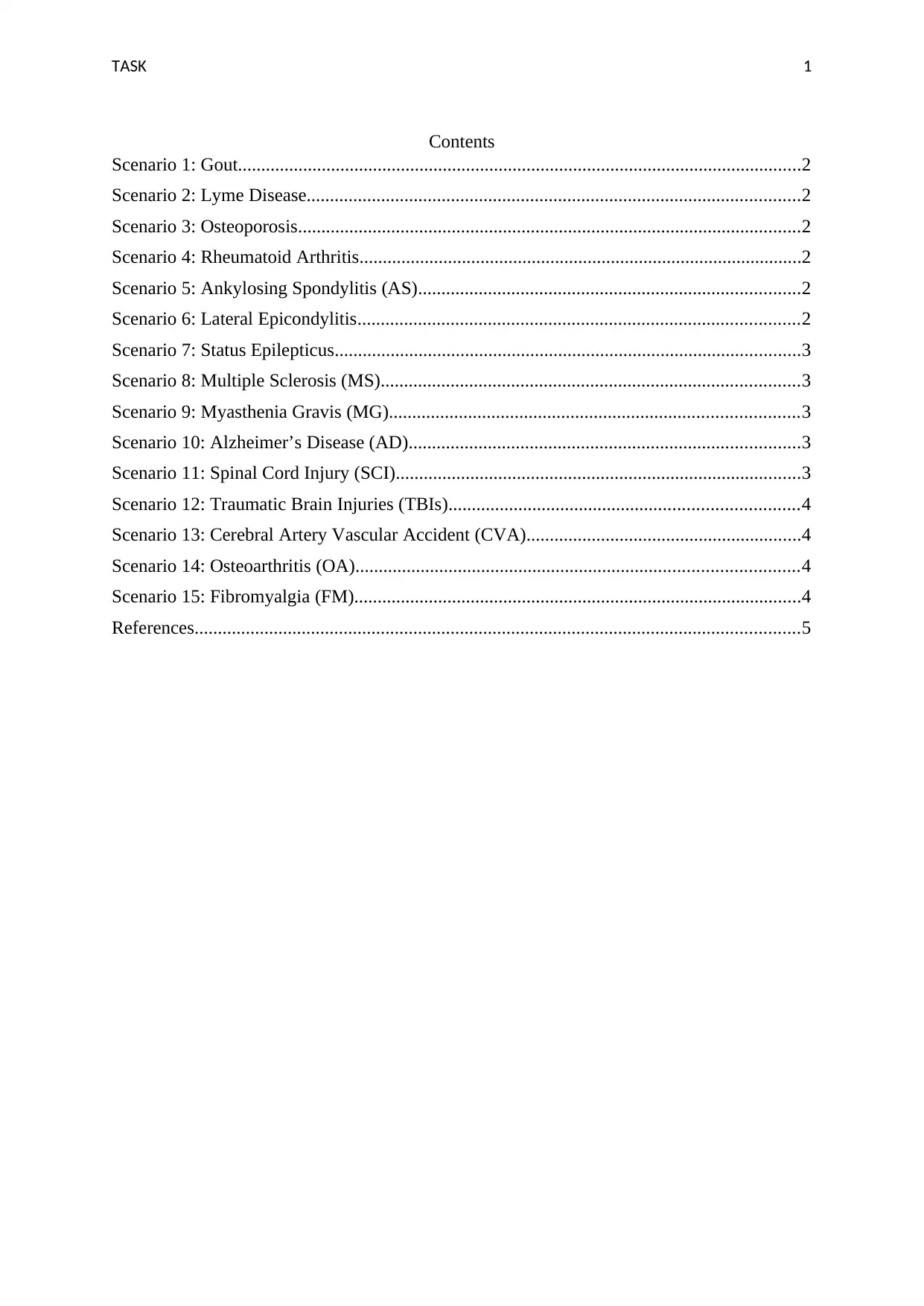
TASK 1
Contents
Scenario 1: Gout.........................................................................................................................2
Scenario 2: Lyme Disease..........................................................................................................2
Scenario 3: Osteoporosis............................................................................................................2
Scenario 4: Rheumatoid Arthritis...............................................................................................2
Scenario 5: Ankylosing Spondylitis (AS)..................................................................................2
Scenario 6: Lateral Epicondylitis...............................................................................................2
Scenario 7: Status Epilepticus....................................................................................................3
Scenario 8: Multiple Sclerosis (MS)..........................................................................................3
Scenario 9: Myasthenia Gravis (MG)........................................................................................3
Scenario 10: Alzheimer’s Disease (AD)....................................................................................3
Scenario 11: Spinal Cord Injury (SCI).......................................................................................3
Scenario 12: Traumatic Brain Injuries (TBIs)...........................................................................4
Scenario 13: Cerebral Artery Vascular Accident (CVA)...........................................................4
Scenario 14: Osteoarthritis (OA)...............................................................................................4
Scenario 15: Fibromyalgia (FM)................................................................................................4
References..................................................................................................................................5
Contents
Scenario 1: Gout.........................................................................................................................2
Scenario 2: Lyme Disease..........................................................................................................2
Scenario 3: Osteoporosis............................................................................................................2
Scenario 4: Rheumatoid Arthritis...............................................................................................2
Scenario 5: Ankylosing Spondylitis (AS)..................................................................................2
Scenario 6: Lateral Epicondylitis...............................................................................................2
Scenario 7: Status Epilepticus....................................................................................................3
Scenario 8: Multiple Sclerosis (MS)..........................................................................................3
Scenario 9: Myasthenia Gravis (MG)........................................................................................3
Scenario 10: Alzheimer’s Disease (AD)....................................................................................3
Scenario 11: Spinal Cord Injury (SCI).......................................................................................3
Scenario 12: Traumatic Brain Injuries (TBIs)...........................................................................4
Scenario 13: Cerebral Artery Vascular Accident (CVA)...........................................................4
Scenario 14: Osteoarthritis (OA)...............................................................................................4
Scenario 15: Fibromyalgia (FM)................................................................................................4
References..................................................................................................................................5
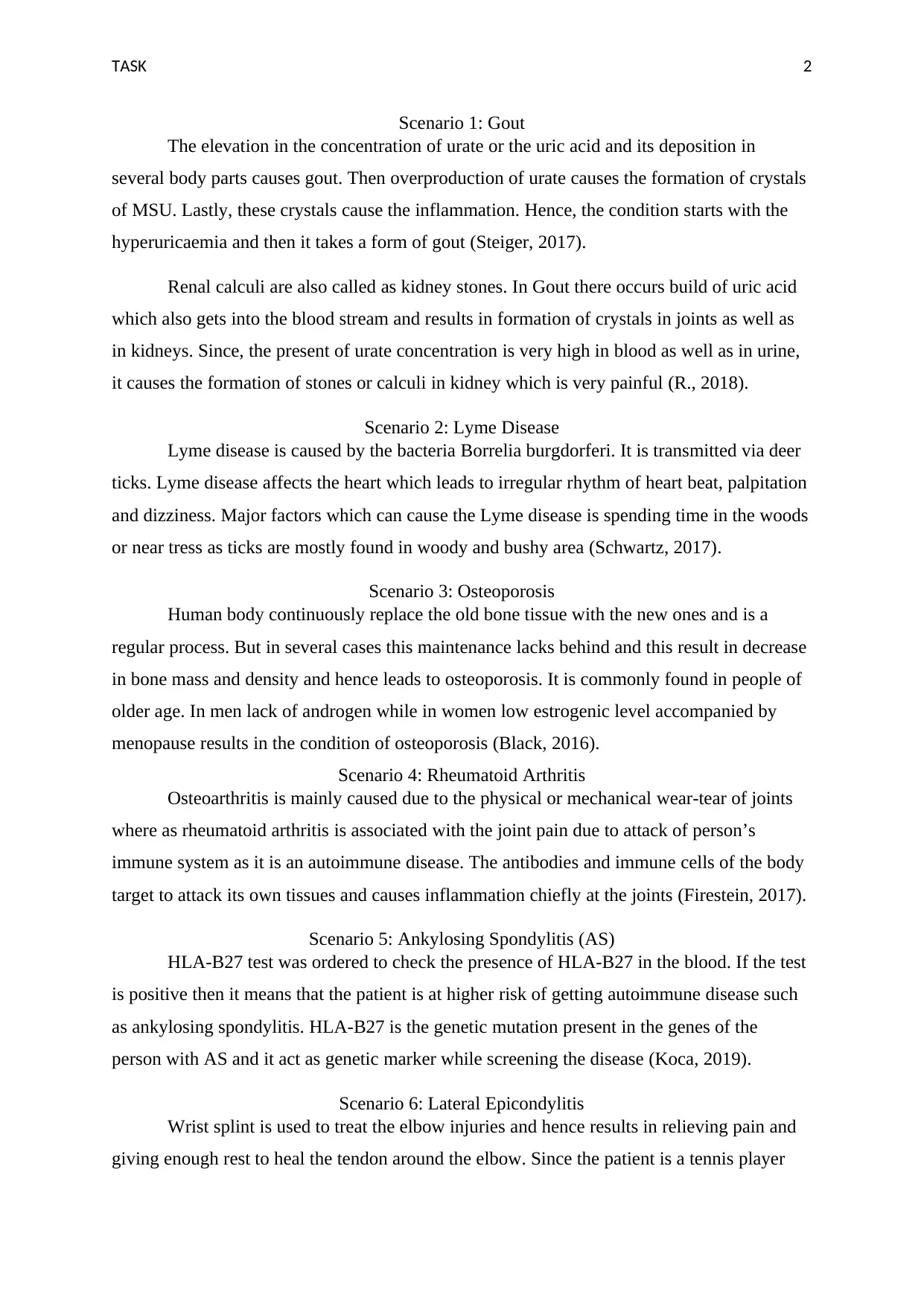
TASK 2
Scenario 1: Gout
The elevation in the concentration of urate or the uric acid and its deposition in
several body parts causes gout. Then overproduction of urate causes the formation of crystals
of MSU. Lastly, these crystals cause the inflammation. Hence, the condition starts with the
hyperuricaemia and then it takes a form of gout (Steiger, 2017).
Renal calculi are also called as kidney stones. In Gout there occurs build of uric acid
which also gets into the blood stream and results in formation of crystals in joints as well as
in kidneys. Since, the present of urate concentration is very high in blood as well as in urine,
it causes the formation of stones or calculi in kidney which is very painful (R., 2018).
Scenario 2: Lyme Disease
Lyme disease is caused by the bacteria Borrelia burgdorferi. It is transmitted via deer
ticks. Lyme disease affects the heart which leads to irregular rhythm of heart beat, palpitation
and dizziness. Major factors which can cause the Lyme disease is spending time in the woods
or near tress as ticks are mostly found in woody and bushy area (Schwartz, 2017).
Scenario 3: Osteoporosis
Human body continuously replace the old bone tissue with the new ones and is a
regular process. But in several cases this maintenance lacks behind and this result in decrease
in bone mass and density and hence leads to osteoporosis. It is commonly found in people of
older age. In men lack of androgen while in women low estrogenic level accompanied by
menopause results in the condition of osteoporosis (Black, 2016).
Scenario 4: Rheumatoid Arthritis
Osteoarthritis is mainly caused due to the physical or mechanical wear-tear of joints
where as rheumatoid arthritis is associated with the joint pain due to attack of person’s
immune system as it is an autoimmune disease. The antibodies and immune cells of the body
target to attack its own tissues and causes inflammation chiefly at the joints (Firestein, 2017).
Scenario 5: Ankylosing Spondylitis (AS)
HLA-B27 test was ordered to check the presence of HLA-B27 in the blood. If the test
is positive then it means that the patient is at higher risk of getting autoimmune disease such
as ankylosing spondylitis. HLA-B27 is the genetic mutation present in the genes of the
person with AS and it act as genetic marker while screening the disease (Koca, 2019).
Scenario 6: Lateral Epicondylitis
Wrist splint is used to treat the elbow injuries and hence results in relieving pain and
giving enough rest to heal the tendon around the elbow. Since the patient is a tennis player
Scenario 1: Gout
The elevation in the concentration of urate or the uric acid and its deposition in
several body parts causes gout. Then overproduction of urate causes the formation of crystals
of MSU. Lastly, these crystals cause the inflammation. Hence, the condition starts with the
hyperuricaemia and then it takes a form of gout (Steiger, 2017).
Renal calculi are also called as kidney stones. In Gout there occurs build of uric acid
which also gets into the blood stream and results in formation of crystals in joints as well as
in kidneys. Since, the present of urate concentration is very high in blood as well as in urine,
it causes the formation of stones or calculi in kidney which is very painful (R., 2018).
Scenario 2: Lyme Disease
Lyme disease is caused by the bacteria Borrelia burgdorferi. It is transmitted via deer
ticks. Lyme disease affects the heart which leads to irregular rhythm of heart beat, palpitation
and dizziness. Major factors which can cause the Lyme disease is spending time in the woods
or near tress as ticks are mostly found in woody and bushy area (Schwartz, 2017).
Scenario 3: Osteoporosis
Human body continuously replace the old bone tissue with the new ones and is a
regular process. But in several cases this maintenance lacks behind and this result in decrease
in bone mass and density and hence leads to osteoporosis. It is commonly found in people of
older age. In men lack of androgen while in women low estrogenic level accompanied by
menopause results in the condition of osteoporosis (Black, 2016).
Scenario 4: Rheumatoid Arthritis
Osteoarthritis is mainly caused due to the physical or mechanical wear-tear of joints
where as rheumatoid arthritis is associated with the joint pain due to attack of person’s
immune system as it is an autoimmune disease. The antibodies and immune cells of the body
target to attack its own tissues and causes inflammation chiefly at the joints (Firestein, 2017).
Scenario 5: Ankylosing Spondylitis (AS)
HLA-B27 test was ordered to check the presence of HLA-B27 in the blood. If the test
is positive then it means that the patient is at higher risk of getting autoimmune disease such
as ankylosing spondylitis. HLA-B27 is the genetic mutation present in the genes of the
person with AS and it act as genetic marker while screening the disease (Koca, 2019).
Scenario 6: Lateral Epicondylitis
Wrist splint is used to treat the elbow injuries and hence results in relieving pain and
giving enough rest to heal the tendon around the elbow. Since the patient is a tennis player
⊘ This is a preview!⊘
Do you want full access?
Subscribe today to unlock all pages.

Trusted by 1+ million students worldwide
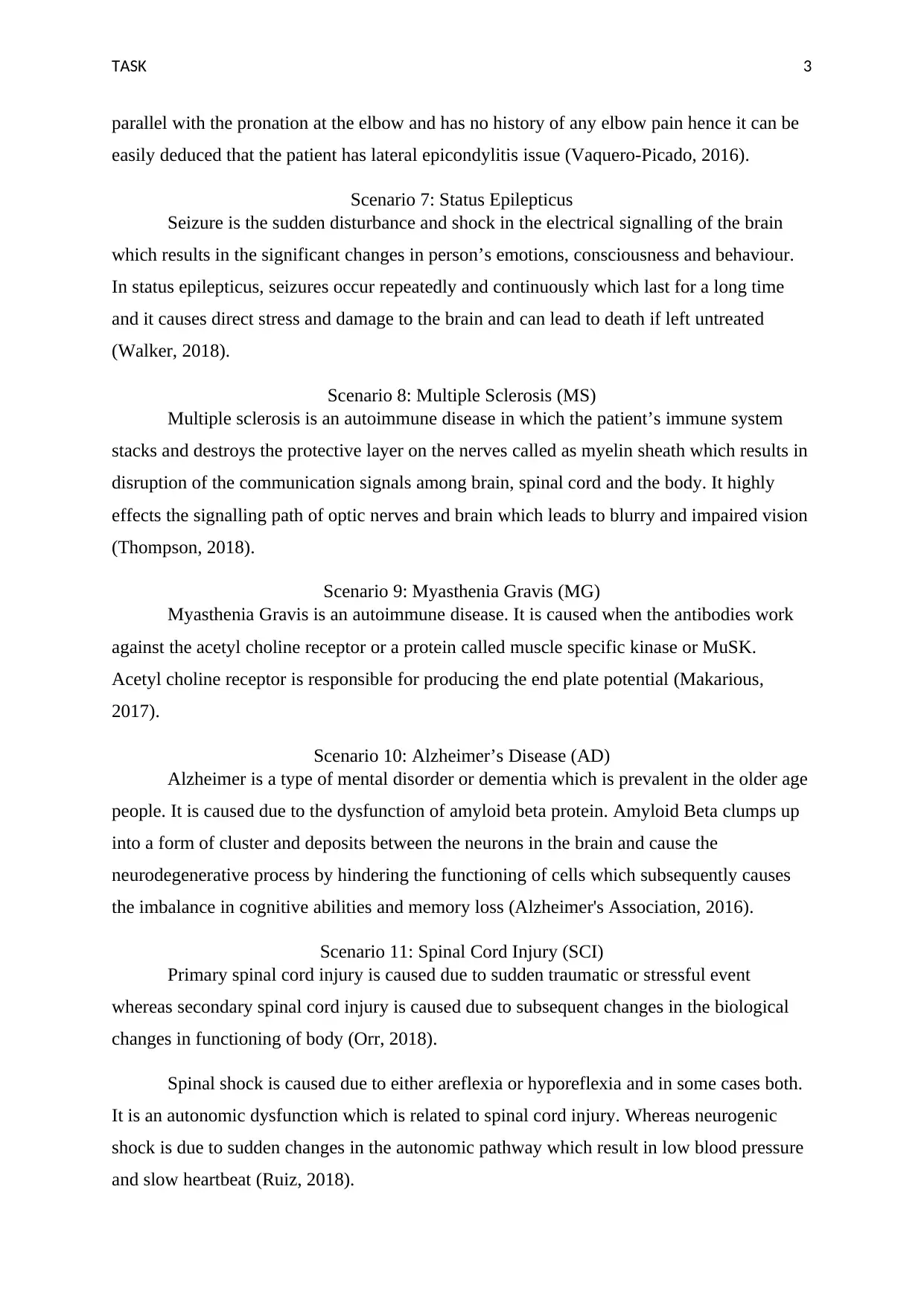
TASK 3
parallel with the pronation at the elbow and has no history of any elbow pain hence it can be
easily deduced that the patient has lateral epicondylitis issue (Vaquero-Picado, 2016).
Scenario 7: Status Epilepticus
Seizure is the sudden disturbance and shock in the electrical signalling of the brain
which results in the significant changes in person’s emotions, consciousness and behaviour.
In status epilepticus, seizures occur repeatedly and continuously which last for a long time
and it causes direct stress and damage to the brain and can lead to death if left untreated
(Walker, 2018).
Scenario 8: Multiple Sclerosis (MS)
Multiple sclerosis is an autoimmune disease in which the patient’s immune system
stacks and destroys the protective layer on the nerves called as myelin sheath which results in
disruption of the communication signals among brain, spinal cord and the body. It highly
effects the signalling path of optic nerves and brain which leads to blurry and impaired vision
(Thompson, 2018).
Scenario 9: Myasthenia Gravis (MG)
Myasthenia Gravis is an autoimmune disease. It is caused when the antibodies work
against the acetyl choline receptor or a protein called muscle specific kinase or MuSK.
Acetyl choline receptor is responsible for producing the end plate potential (Makarious,
2017).
Scenario 10: Alzheimer’s Disease (AD)
Alzheimer is a type of mental disorder or dementia which is prevalent in the older age
people. It is caused due to the dysfunction of amyloid beta protein. Amyloid Beta clumps up
into a form of cluster and deposits between the neurons in the brain and cause the
neurodegenerative process by hindering the functioning of cells which subsequently causes
the imbalance in cognitive abilities and memory loss (Alzheimer's Association, 2016).
Scenario 11: Spinal Cord Injury (SCI)
Primary spinal cord injury is caused due to sudden traumatic or stressful event
whereas secondary spinal cord injury is caused due to subsequent changes in the biological
changes in functioning of body (Orr, 2018).
Spinal shock is caused due to either areflexia or hyporeflexia and in some cases both.
It is an autonomic dysfunction which is related to spinal cord injury. Whereas neurogenic
shock is due to sudden changes in the autonomic pathway which result in low blood pressure
and slow heartbeat (Ruiz, 2018).
parallel with the pronation at the elbow and has no history of any elbow pain hence it can be
easily deduced that the patient has lateral epicondylitis issue (Vaquero-Picado, 2016).
Scenario 7: Status Epilepticus
Seizure is the sudden disturbance and shock in the electrical signalling of the brain
which results in the significant changes in person’s emotions, consciousness and behaviour.
In status epilepticus, seizures occur repeatedly and continuously which last for a long time
and it causes direct stress and damage to the brain and can lead to death if left untreated
(Walker, 2018).
Scenario 8: Multiple Sclerosis (MS)
Multiple sclerosis is an autoimmune disease in which the patient’s immune system
stacks and destroys the protective layer on the nerves called as myelin sheath which results in
disruption of the communication signals among brain, spinal cord and the body. It highly
effects the signalling path of optic nerves and brain which leads to blurry and impaired vision
(Thompson, 2018).
Scenario 9: Myasthenia Gravis (MG)
Myasthenia Gravis is an autoimmune disease. It is caused when the antibodies work
against the acetyl choline receptor or a protein called muscle specific kinase or MuSK.
Acetyl choline receptor is responsible for producing the end plate potential (Makarious,
2017).
Scenario 10: Alzheimer’s Disease (AD)
Alzheimer is a type of mental disorder or dementia which is prevalent in the older age
people. It is caused due to the dysfunction of amyloid beta protein. Amyloid Beta clumps up
into a form of cluster and deposits between the neurons in the brain and cause the
neurodegenerative process by hindering the functioning of cells which subsequently causes
the imbalance in cognitive abilities and memory loss (Alzheimer's Association, 2016).
Scenario 11: Spinal Cord Injury (SCI)
Primary spinal cord injury is caused due to sudden traumatic or stressful event
whereas secondary spinal cord injury is caused due to subsequent changes in the biological
changes in functioning of body (Orr, 2018).
Spinal shock is caused due to either areflexia or hyporeflexia and in some cases both.
It is an autonomic dysfunction which is related to spinal cord injury. Whereas neurogenic
shock is due to sudden changes in the autonomic pathway which result in low blood pressure
and slow heartbeat (Ruiz, 2018).
Paraphrase This Document
Need a fresh take? Get an instant paraphrase of this document with our AI Paraphraser
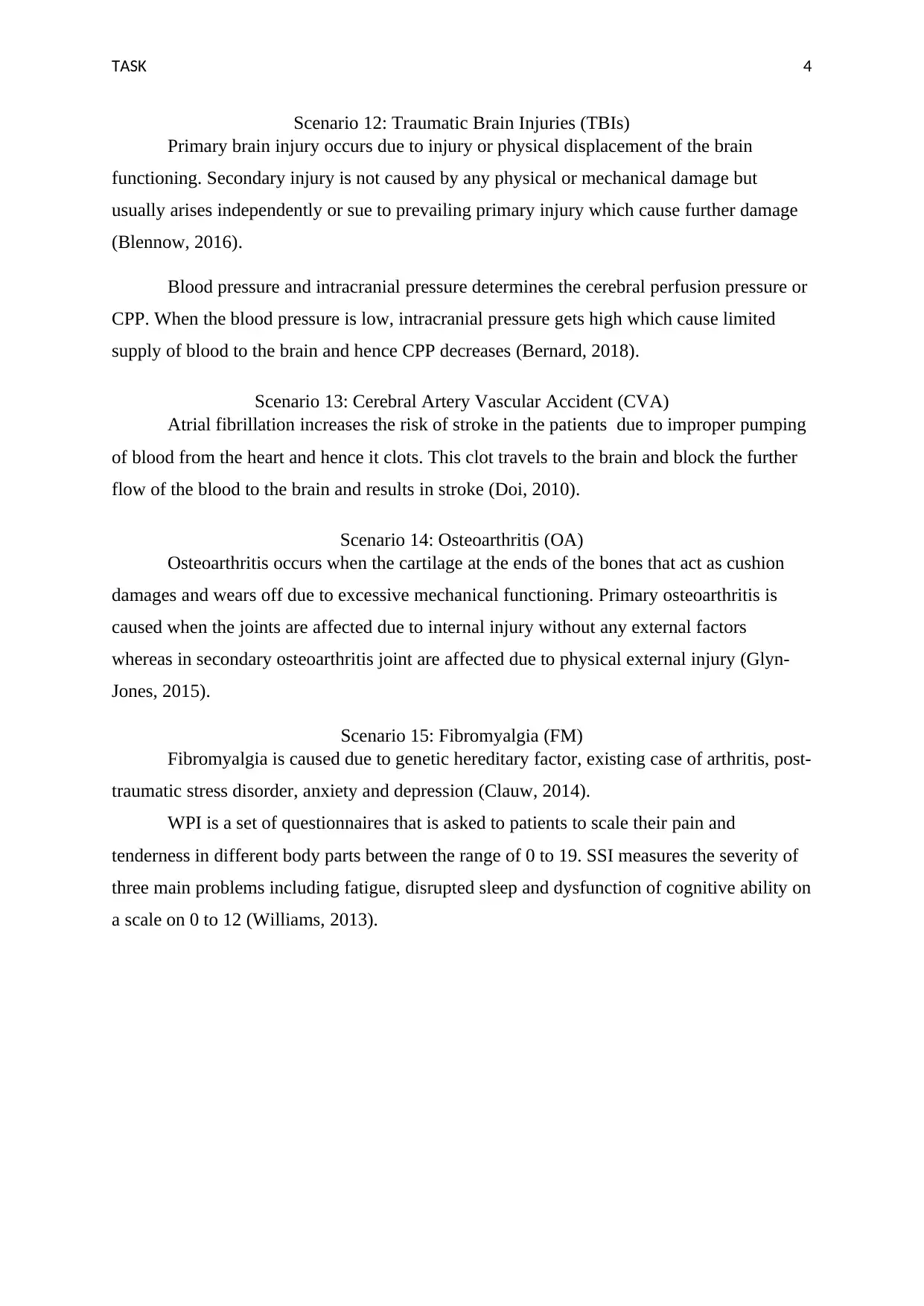
TASK 4
Scenario 12: Traumatic Brain Injuries (TBIs)
Primary brain injury occurs due to injury or physical displacement of the brain
functioning. Secondary injury is not caused by any physical or mechanical damage but
usually arises independently or sue to prevailing primary injury which cause further damage
(Blennow, 2016).
Blood pressure and intracranial pressure determines the cerebral perfusion pressure or
CPP. When the blood pressure is low, intracranial pressure gets high which cause limited
supply of blood to the brain and hence CPP decreases (Bernard, 2018).
Scenario 13: Cerebral Artery Vascular Accident (CVA)
Atrial fibrillation increases the risk of stroke in the patients due to improper pumping
of blood from the heart and hence it clots. This clot travels to the brain and block the further
flow of the blood to the brain and results in stroke (Doi, 2010).
Scenario 14: Osteoarthritis (OA)
Osteoarthritis occurs when the cartilage at the ends of the bones that act as cushion
damages and wears off due to excessive mechanical functioning. Primary osteoarthritis is
caused when the joints are affected due to internal injury without any external factors
whereas in secondary osteoarthritis joint are affected due to physical external injury (Glyn-
Jones, 2015).
Scenario 15: Fibromyalgia (FM)
Fibromyalgia is caused due to genetic hereditary factor, existing case of arthritis, post-
traumatic stress disorder, anxiety and depression (Clauw, 2014).
WPI is a set of questionnaires that is asked to patients to scale their pain and
tenderness in different body parts between the range of 0 to 19. SSI measures the severity of
three main problems including fatigue, disrupted sleep and dysfunction of cognitive ability on
a scale on 0 to 12 (Williams, 2013).
Scenario 12: Traumatic Brain Injuries (TBIs)
Primary brain injury occurs due to injury or physical displacement of the brain
functioning. Secondary injury is not caused by any physical or mechanical damage but
usually arises independently or sue to prevailing primary injury which cause further damage
(Blennow, 2016).
Blood pressure and intracranial pressure determines the cerebral perfusion pressure or
CPP. When the blood pressure is low, intracranial pressure gets high which cause limited
supply of blood to the brain and hence CPP decreases (Bernard, 2018).
Scenario 13: Cerebral Artery Vascular Accident (CVA)
Atrial fibrillation increases the risk of stroke in the patients due to improper pumping
of blood from the heart and hence it clots. This clot travels to the brain and block the further
flow of the blood to the brain and results in stroke (Doi, 2010).
Scenario 14: Osteoarthritis (OA)
Osteoarthritis occurs when the cartilage at the ends of the bones that act as cushion
damages and wears off due to excessive mechanical functioning. Primary osteoarthritis is
caused when the joints are affected due to internal injury without any external factors
whereas in secondary osteoarthritis joint are affected due to physical external injury (Glyn-
Jones, 2015).
Scenario 15: Fibromyalgia (FM)
Fibromyalgia is caused due to genetic hereditary factor, existing case of arthritis, post-
traumatic stress disorder, anxiety and depression (Clauw, 2014).
WPI is a set of questionnaires that is asked to patients to scale their pain and
tenderness in different body parts between the range of 0 to 19. SSI measures the severity of
three main problems including fatigue, disrupted sleep and dysfunction of cognitive ability on
a scale on 0 to 12 (Williams, 2013).

TASK 5
References
Alzheimer's Association. (2016). 2016 Alzheimer's disease facts and figures. Alzheimer's &
Dementia, 12(4), 459-509.
Bernard, F. A. (2018). Individualizing Cerebral Perfusion Pressure Targets. Critical care
medicine, 46(2), 175.
Black, D. M. (2016). Postmenopausal osteoporosis. New England Journal of Medicine,
374(3), 254-262.
Blennow, K. D. (2016). Traumatic brain injuries. Nature reviews Disease primers , 2(1), 1-
19.
Clauw, D. J. (2014). Fibromyalgia: a clinical review. Jama, 311(15), 1547-1555.
Doi, K. &. (2010). Importance of cerebral artery risk evaluation before off-pump coronary
artery bypass grafting to avoid perioperative stroke. European Journal of Cardio-
thoracic Surgery, 38(5), 568-572.
Firestein, G. S. (2017). Immunopathogenesis of rheumatoid arthritis. Immunity, 46(2), 183-
196.
Glyn-Jones, S. P. (2015). Osteoarthritis. The Lancet, 386(9991), 376-387.
Koca, T. T. (2019). Foot functions in ankylosing spondylitis. Clinical rheumatology, 38(4),
1083-1088.
Makarious, D. H. (2017). Myasthenia gravis: an emerging toxicity of immune checkpoint
inhibitors. European Journal of Cancer, 82, 128-136.
Orr, M. B. (2018). Interactions of primary insult biomechanics and secondary cascades in
spinal cord injury: implications for therapy. Neural regeneration research, 12(10),
1618.
R., L. S. (2018). Clinical significance of SLC2A9/GLUT9 rs11722228 polymorphisms in
gout. International journal of rheumatic diseases,, 21(3), 705-709.
Ruiz, I. A. (2018). Incidence and natural progression of neurogenic shock after traumatic
spinal cord injury. Journal of neurotrauma , 35(3), 461-466.
Schwartz, A. M. (2017). Surveillance for Lyme disease—United States, 2008–2015. MMWR
Surveillance Summaries, 66(22), 1.
Steiger, S. &. (2017). Molecular pathophysiology of gout. Trends in molecular medicine,
23(8), 756-768.
Thompson, A. J. (2018). Diagnosis of multiple sclerosis: 2017 revisions of the McDonald
criteria. The Lancet Neurology, 17(2), 162-173.
Vaquero-Picado, A. B. (2016). Lateral epicondylitis of the elbow. EFORT open reviews,
1(11), 391-397.
Walker, M. C. (2018). Pathophysiology of status epilepticus. Neuroscience letters, 667, 84-
91.
References
Alzheimer's Association. (2016). 2016 Alzheimer's disease facts and figures. Alzheimer's &
Dementia, 12(4), 459-509.
Bernard, F. A. (2018). Individualizing Cerebral Perfusion Pressure Targets. Critical care
medicine, 46(2), 175.
Black, D. M. (2016). Postmenopausal osteoporosis. New England Journal of Medicine,
374(3), 254-262.
Blennow, K. D. (2016). Traumatic brain injuries. Nature reviews Disease primers , 2(1), 1-
19.
Clauw, D. J. (2014). Fibromyalgia: a clinical review. Jama, 311(15), 1547-1555.
Doi, K. &. (2010). Importance of cerebral artery risk evaluation before off-pump coronary
artery bypass grafting to avoid perioperative stroke. European Journal of Cardio-
thoracic Surgery, 38(5), 568-572.
Firestein, G. S. (2017). Immunopathogenesis of rheumatoid arthritis. Immunity, 46(2), 183-
196.
Glyn-Jones, S. P. (2015). Osteoarthritis. The Lancet, 386(9991), 376-387.
Koca, T. T. (2019). Foot functions in ankylosing spondylitis. Clinical rheumatology, 38(4),
1083-1088.
Makarious, D. H. (2017). Myasthenia gravis: an emerging toxicity of immune checkpoint
inhibitors. European Journal of Cancer, 82, 128-136.
Orr, M. B. (2018). Interactions of primary insult biomechanics and secondary cascades in
spinal cord injury: implications for therapy. Neural regeneration research, 12(10),
1618.
R., L. S. (2018). Clinical significance of SLC2A9/GLUT9 rs11722228 polymorphisms in
gout. International journal of rheumatic diseases,, 21(3), 705-709.
Ruiz, I. A. (2018). Incidence and natural progression of neurogenic shock after traumatic
spinal cord injury. Journal of neurotrauma , 35(3), 461-466.
Schwartz, A. M. (2017). Surveillance for Lyme disease—United States, 2008–2015. MMWR
Surveillance Summaries, 66(22), 1.
Steiger, S. &. (2017). Molecular pathophysiology of gout. Trends in molecular medicine,
23(8), 756-768.
Thompson, A. J. (2018). Diagnosis of multiple sclerosis: 2017 revisions of the McDonald
criteria. The Lancet Neurology, 17(2), 162-173.
Vaquero-Picado, A. B. (2016). Lateral epicondylitis of the elbow. EFORT open reviews,
1(11), 391-397.
Walker, M. C. (2018). Pathophysiology of status epilepticus. Neuroscience letters, 667, 84-
91.
⊘ This is a preview!⊘
Do you want full access?
Subscribe today to unlock all pages.

Trusted by 1+ million students worldwide

TASK 6
Williams, D. A. (2013). The importance of psychological assessment in chronic pain.
Current opinion in urology, 554.
Williams, D. A. (2013). The importance of psychological assessment in chronic pain.
Current opinion in urology, 554.
1 out of 7
Your All-in-One AI-Powered Toolkit for Academic Success.
+13062052269
info@desklib.com
Available 24*7 on WhatsApp / Email
![[object Object]](/_next/static/media/star-bottom.7253800d.svg)
Unlock your academic potential
Copyright © 2020–2025 A2Z Services. All Rights Reserved. Developed and managed by ZUCOL.
